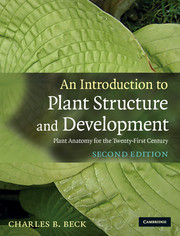Book contents
- Frontmatter
- Contents
- Preface to the second edition
- Preface
- Acknowledgements
- General references
- Chapter 1 Problems of adaptation to a terrestrial environment
- Chapter 2 An overview of plant structure and development
- Chapter 3 The protoplast of the eukaryotic cell
- Chapter 4 Structure and development of the cell wall
- Chapter 5 Meristems of the shoot and their role in plant growth and development
- Chapter 6 Morphology and development of the primary vascular system of the stem
- Chapter 7 Sympodial systems and patterns of nodal anatomy
- Chapter 8 The epidermis
- Chapter 9 The origin of secondary tissue systems and the effect of their formation on the primary body in seed plants
- Chapter 10 The vascular cambium: structure and function
- Chapter 11 Secondary xylem
- Chapter 12 The phloem
- Chapter 13 Periderm, rhytidome, and the nature of bark
- Chapter 14 Unusual features of structure and development in stems and roots
- Chapter 15 Secretion in plants
- Chapter 16 The root
- Chapter 17 The leaf
- Chapter 18 Reproduction and the origin of the sporophyte
- Glossary
- Index
- References
Chapter 10 - The vascular cambium: structure and function
Published online by Cambridge University Press: 05 June 2012
- Frontmatter
- Contents
- Preface to the second edition
- Preface
- Acknowledgements
- General references
- Chapter 1 Problems of adaptation to a terrestrial environment
- Chapter 2 An overview of plant structure and development
- Chapter 3 The protoplast of the eukaryotic cell
- Chapter 4 Structure and development of the cell wall
- Chapter 5 Meristems of the shoot and their role in plant growth and development
- Chapter 6 Morphology and development of the primary vascular system of the stem
- Chapter 7 Sympodial systems and patterns of nodal anatomy
- Chapter 8 The epidermis
- Chapter 9 The origin of secondary tissue systems and the effect of their formation on the primary body in seed plants
- Chapter 10 The vascular cambium: structure and function
- Chapter 11 Secondary xylem
- Chapter 12 The phloem
- Chapter 13 Periderm, rhytidome, and the nature of bark
- Chapter 14 Unusual features of structure and development in stems and roots
- Chapter 15 Secretion in plants
- Chapter 16 The root
- Chapter 17 The leaf
- Chapter 18 Reproduction and the origin of the sporophyte
- Glossary
- Index
- References
Summary
Perspective
It is difficult to overemphasize the importance of the vascular cambium which produces secondary xylem and secondary phloem. In the following two chapters we shall discuss in detail the structure, functions, and the importance to the plant of these tissues which also have great significance for mankind. Wood (i.e., secondary xylem) is a material of which the buildings in which we live and work are constructed. It is the source of the paper on which we write, on which newspapers, magazines, and books are printed, and of many synthetic fabrics such as rayon and nylon of which our clothes are made, to name only a few of its many uses. The phloem is of the utmost importance as the tissue through which photosynthate is transported from the leaves to sites of utilization or storage in the plant. It is the availability of photosynthate which makes possible the development of nutritious, edible parts of plants, such as fruits, nuts and grains, bulbs, tubers, other edible roots, and leaves, etc., the source of so much of the food supply of humans and other organisms. It is important, therefore, that we know more about the detailed structure and activity of the vascular cambium, a lateral meristem of such great significance.
Structure of the vascular cambium
It is generally agreed that the vascular cambium is composed of a layer of cells only one cell thick, and that all of these cells are meristematic cambial initials from which cells of the secondary xylem and secondary phloem are derived.
Information
- Type
- Chapter
- Information
- An Introduction to Plant Structure and DevelopmentPlant Anatomy for the Twenty-First Century, pp. 166 - 183Publisher: Cambridge University PressPrint publication year: 2010
